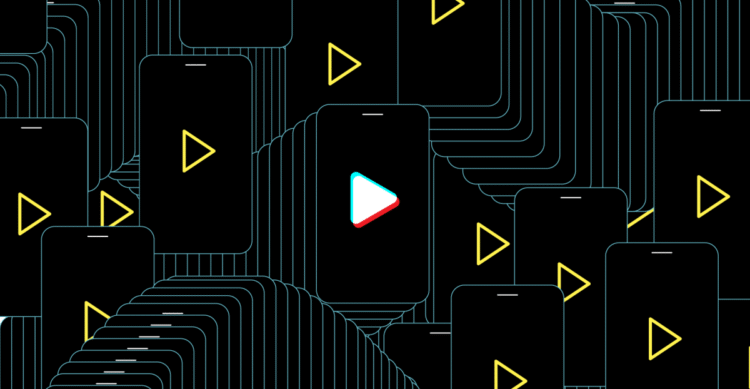As an elder millennial, I’ve tried to avoid TikTok because of its documented brainrot potential and despite the fact that it means missing out on an endless supply of fun and strangely specific memes. But somehow, little short-form vertical videos keep finding their way to me.
Whether they’re on Instagram, Netflix, or Pinterest, swipeable smartphone-shaped videos have taken over the internet. They’re also showing up in places you wouldn’t expect, like Spotify, LinkedIn, and even the New York Times. And whether you enjoy these bite-size bits of content or not, the situation is about to get much weirder.
The dark future of vertical video
In the near future, the internet may not only be wall-to-wall little videos. Those little videos may also be filled with slop, the term for AI-generated garbage content that is perhaps even more insidious in robbing us of our attention.
Last week, Google started rolling out its Veo 3 AI-powered video generation model, which can create eight-second clips, complete with realistic soundtracks, based on text prompts. After creating a dozen videos of her own, including some for kids, Allison Johnson at The Verge called this tool “a slop monger’s dream” that’s “more than a little creepy and way more sophisticated” than she’d imagined. String together a few of these clips, and you’ve got a piece of short-form content perfect for TikTok or any of its antecedents that took mere minutes to create. YouTube announced last month that the tool would be built right into its own TikTok clone, YouTube Shorts. These videos are already taking over short-form video platforms. Some of them are racist.
AI slop may soon also dominate the ads you’re served on these platforms, too. These ads, while currently laughable, will get much better, according to Mark Zuckerberg, who says Meta will completely automate the creation of ads and even make it possible for ads to exist in infinite versions and evolve based on when and where a person sees them. And as algorithmic feeds of short-form videos spread to more places online, it will be increasingly hard to avoid them.
We’ve known for a while that the rise of AI would flood the internet with slop. Slop is already remarkably popular on YouTube, where nearly half of the 10 most popular channels contain AI-generated content. There are even virtual personalities powered by AI earning millions on YouTube. These platforms know that making content easier to produce will lead to more content, which leads to more engagement, which leads to more ads, which ultimately leads to a less enriching, more addictive internet. That’s why YouTube is pushing Veo 3 to its creators, and why, as of last month, TikTok and Open AI have pushed out similar tools.
This wouldn’t be such a concern if you wanted to seek out awful AI-generated videos. Instead, the slop finds you unwittingly and drowns you in anxiety.
These platforms know that making content easier to produce will lead to more content, which leads to more engagement, which leads to more ads, which ultimately leads to a less enriching, more addictive internet.
People already spend a staggering amount of time on TikTok: 108 minutes a day, which is more than double the time spent on Instagram. There are many, many studies showing how more TikTok use increases anxiety and stress, especially in young people. (One of them coined the term “TikTok brain” and not in a good way.) We’ve also known for a while that watching TikTok has the side effect of shredding your attention span. Researchers have found that TikTok disrupts your ability to complete a task when interrupted. Our attention spans while looking at a screen have shrunk, on average, from two and a half minutes in 2004 to just 47 seconds, which is incidentally quite close to the average length of a TikTok video.
“You can think of it as attentional capacity, and we can use that capacity to get work done, to do important things,” said Gloria Mark, author of Attention Span and professor of informatics at the University of California Irvine, whose research landed on that 47-second number. “But if we’re switching our attention, that’s draining our tank of resources, and then we just don’t have the capacity anymore to pay attention.”
Before the next era of TikTok and its clones overwhelms you, it helps to know how we got here and how to run the other direction.
Can you opt out of the endless-loop internet?
There’s a popular narrative that TikTok owes its success to Vine, a short-form video service founded in 2012 only to be bought by Twitter a few months later. It’s a nice thought. Vine, like Twitter itself, was accidentally successful. While many young people first encountered a feed for weird and hilarious short-form videos on Vine, it was the TikTok algorithm that led to that platform’s success, not to mention the long line of companies trying to draft off that success.
That algorithm finds its roots in a viral news app called Toutiao, which ByteDance released in China the same year that Vine launched in the US. (Yes, this is the same ByteDance that now owns TikTok.) The platform’s big innovation was a complex recommendation engine that used machine learning, a type of AI, to create a highly personalized feed for its users based on their interests and behavior — down to their swipes, location, and even their phone’s battery life — rather than what people you know are doing online. The algorithm proved extremely effective at getting people to spend more time on the app. ByteDance made this algorithm the foundation of TikTok’s video feed, when it launched in 2017 (a version of the app, Douyin, launched in China two years earlier).
If you find yourself stuck
Try these three tips from professor Gloria Mark:
- Take breaks. If, rather than enjoying yourself, you find yourself foraging for interesting content, stand up and go outside and look at a tree. There are lots of apps that prompt you to put down the device.
- Be intentional rather than automatic when you use any app. If you tap TikTok because you don’t know what else to do, that’s a sign that you’re tired and low on cognitive resources.
- Think ahead to your future self. Visualize what you want at the end of your day and how you’ll get there. It probably doesn’t involve spending 108 minutes looking at TikTok.
Early on, a one-minute length limit meant that TikTok users were fed videos constantly, often serendipitously, on their For You page. That limit has since been extended to 60 minutes, but users have also learned they can swipe to see a new, unexpected video as soon as they’re bored. This can lead users to keep searching for good videos, which are effectively rewards, triggering dopamine release and effectively getting them addicted to the feedback loop. As Mark put it, “The hardest behavior to extinguish, to stop, is randomly reinforced behavior, and the reason is because of the randomness of the rewards coming.”
The short-form nature of these videos, rapid context-switching, and resultant digital overload has multiple negative effects. A 2023 study from researchers in Germany found that TikTok use impairs our prospective memory, which is what allows you to hold more than one thought in your head when you’re distracted. The subjects of the study were given a task, then interrupted and allowed to scroll Twitter, watch YouTube, thumb through TikTok, or do nothing. The people who chose TikTok were nearly 40 percent more likely to forget what they were doing.
Researchers studying this phenomenon argue that this amounts to a dark pattern, a design that manipulates you to make certain choices. You’ve encountered dark patterns on websites that trick you into signing up for a newsletter or an ad you can’t click out of. Torrents of short-form videos like you see on TikTok are especially pernicious because the feeds are designed to keep you fully engaged and foraging for good content.
“They keep us in an endless loop. We kind of detach from the things that we were engaged with before,” Francesco Chiossi, a researcher at LMU Munich and the study’s lead author, told me. “They are engineered to maximize engagement at the expense of our attention and stability of what we call goal-directed behavior.”
It would be comforting for me to report that you can easily avoid getting stuck in these loops. It’s actually getting harder. You can avoid TikTok, but you might love Netflix, which is rolling out its own TikTok-like video feed on its mobile app. I use Spotify daily, sometimes against my better judgment, but the discovery feature keeps pushing me to watch little video clips rather than simply listen to music. On the LinkedIn video tab, its TikTok clone, a work influencer recently warned me against “peanut-buttering every channel instead of going deep on a few channels.” I spent at least 47 seconds trying to figure out what that meant.
There’s a pretty straightforward lesson here, though. If you like to watch these little videos, by all means: Enjoy. But know that, like most free things big tech companies make today, these products are designed to keep you engaged, to steal as much of your attention as possible as they collect data about you and serve ads to you based on what that data reveals. TikTok and its many little siblings are free because you’re the product.
Consider taking some of the minutes — or hours — back from TikTok and its many little video clones. You might discover something wonderful in the real world, if you pay attention.
A version of this story was also published in the User Friendly newsletter. Sign up here so you don’t miss the next one!
















